Hyperthyroidism is one of the most common endocrine conditions affecting cats, especially older cats over the age of 10 years. Some veterinarians estimate that about 5 to 10% of middle- to old-aged cats will develop hyperthyroidism, and, due to factors that may include environmental exposures, that number is on the rise.
Thyroid hormones normally regulate many of the body’s metabolic processes. As circulating levels of thyroid hormones rise higher and higher in cats with hyperthyroidism, a progressive increase in their metabolic rate develops: this leads to a multitude of changes throughout the entire body, including loss of weight and muscle wasting. High thyroid hormone concentrations also interact with and stimulate the central nervous system, which commonly leads to increased activity or restlessness, as well as other behavior problems.
Clinical signs associated with hyperthyroidism can be quite dramatic and cats can become seriously ill with this condition. Untreated, hyperthyroidism in cats can lead to heart or kidney failure and can be fatal.
However, this disorder is a very treatable disease and most hyperthyroid cats will make a complete recovery. I’d discuss the various treatment options, together with pros and cons of each form of treatment, later in this current series of posts I’m doing on feline hyperthyroidism.
Do You Know the Clinical Signs of Hyperthyroidism to Watch for in Your Cat?
Here I’ve listed the top 10 most common signs that cats with hyperthyroidism can develop, from most common to least frequent.
Your cat doesn’t need to have all of these clinical signs or symptoms in order to have an overactive thyroid problem. But if your cat has one or more of these signs, especially if he or she is older than 10 years of age, you should definitely have your cat tested for hyperthyroidism.
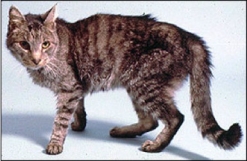 1. Weight loss
1. Weight loss
Weight loss despite a normal to increased appetite is the classic and most common sign of hyperthyroidism in cats. Hyperthyroidism is so common that it should always be considered as a possibility in any middle-aged to older cats that has lost weight, even in none of the other clinical features of the disease are present.
The weight loss associated is generally progressive and is usually first noticed by the owner as a loss of muscle mass around the cat’s back (spine).
With time, severe muscle wasting, emaciation, and death from starvation can occur if the cat’s hyperthyroidism is left untreated.
2. Increased appetite
The weight loss characteristic of cats with hyperthyroidism is typically associated with an increase in the cat’s appetite. This increase in appetite can be dramatic, with some cats doubling the amount of food eaten and frequently begging for food. Hyperthyroid cats eat more in an attempt to compensate for their higher-than-normal metabolic rate by increasing the number of calories ingested. Unfortunately, most cats cannot fully compensate and continue to loss weight even if they have a good to increased appetite.
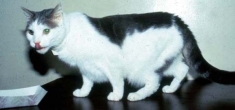 Although most hyperthyroid cats have an increased appetite, some cats with mild hyperthyroidism will maintain a normal appetite, with no obvious change in amount of food consumed.
Although most hyperthyroid cats have an increased appetite, some cats with mild hyperthyroidism will maintain a normal appetite, with no obvious change in amount of food consumed.
A few hyperthyroid cats will even develop a reduced appetite that is improved after treatment of their hyperthyroidism. Most of these cats with a poor appetite have a rare form of hyperthyroidism called “apathetic hyperthyroidism,” which is described in more detail below (see clinical sign Number 10).
3. Hyperactive, increased energy, or nervous behavior
Hyperactivity, exhibited particularly as nervousness or restlessness, is relatively common in cats with hyperthyroidism. In extreme hyperthyroidism, muscle tremor or twitching may be apparent, and affected cats are often described as having an anxious or frantic facial expression.
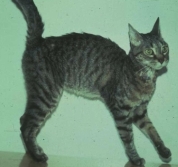 In some cats, especially in the earlier stages of their hyperthyroidism, their owner can misconstrue such increased activity and energy as a positive sign of health. One must remember that cats normally become quite sedentary as they age so this change of behavior leading to increased energy and activity is almost always a manifestation of an underlying disease processes.
In some cats, especially in the earlier stages of their hyperthyroidism, their owner can misconstrue such increased activity and energy as a positive sign of health. One must remember that cats normally become quite sedentary as they age so this change of behavior leading to increased energy and activity is almost always a manifestation of an underlying disease processes.
Some of these behavior signs — especially restlessness or aggression — are often more noticeable to the examining veterinarian than to the cat owners themselves. Many hyperthyroid cats have an impaired tolerance for stress and do not wish to be held or restrained. Some will even develop a “panic attack” as a result of an impaired tolerance for examination or restraint during blood sampling. These cats may also develop panting, overt respiratory distress, weakness, and even collapse during these episodes.
To see a video of severe anxiety in a cat with severe untreated hyperthyroidism, see my previous blog post.
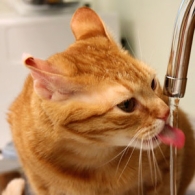 4. Increased thirst and urination
4. Increased thirst and urination
About half of cats with hyperthyroidism will show signs of increased thirst (polydipsia) and urination (polyuria). Veterinarians often refer to polyuria and polydipsia simply as “PU/PD.”
There are a number of possible reasons for the increase in thirst and urination seen in hyperthyroid cats. The most common explanation for the PU/PD is mild, concurrent kidney disease. About a third of all cats older than 12 years of age will develop kidney disease, so the finding of concomitant kidney disease in a hyperthyroid cat should not be surprising.
Two other causes for polyuria and polydipsia in cats with hyperthyroidism include the following:
1. Increased kidney blood flow occurs secondary to hyperthyroidism, which can lead to what’s called “renal medullary washout.” This leads to the inability of the cat to concentration their urine normally.
2. Compulsive water drinking secondary to a behavior problem may also occur in some cats with hyperthyroidism.
In both groups of these cats, the increased thirst and urination return to normal after treatment of the cat’s hyperthyroidism.
5. Vomiting or regurgitation
Gastrointestinal signs including intermittent vomiting or regurgitation are fairly common in cats with hyperthyroidism. Vomiting may result from a direct action of thyroid hormones on an area of the brain called the chemoreceptor trigger zone. In other cats, the vomiting can result from gastric stasis (e.g., delay emptying of the stomach).
Vomiting appears to be more common in cats from multi-cat households and usually occurs shortly after feeding. Therefore, vomiting and regurgitation in most hyperthyroid cats may simply be related to rapid overeating. In other words, these cats eats too much food too fast, overfill their stomach, and then vomit.
One solution to this problem during the early stages of treatment is too feed the cat smaller amounts of food more frequently (every 3 to 4 hours, if possible).
6. Anxiety, night yowling, confusion, aimless pacing
The behavioral sign most obvious to owners is night yowling (a long loud mournful cry). This yowling most often occurs in the middle of the night for no apparent reason, and generally causes the owner to awaken. Aimless pacing and easily interrupted sleep patterns may also occur in some hyperthyroid cats.
All of these behavior signs appear to reflect a state of confusion, anxiety, or restless associated with the increased central nervous stimulation caused by the hyperthyroidism.
7. Diarrhea, soft stools, voluminous stools
Soft stools and diarrhea can occur in about a third of cats with hyperthyroidism. Other cats develop large voluminous stools with frequent defecation.
It is likely that accelerated gastrointestinal transit contributes to the increased frequency of defecation, soft stools and diarrhea. Some of these cats also develop malabsorption, in which they do not normally absorb the food from the intestinal tract.
8. Fast respiratory rate, panting, difficulty breathing
Respiratory abnormalities, including a rapid respiratory rate, panting, or difficulty in breathing at rest, are also common. Respiratory signs tend to occur most frequently during periods of stress. However, some affected cats will be noticeably intolerant of heat and seek out cooler places to sit, and some (especially advanced cases) may pant or breath more rapidly in warm or hot home environments.
In the absence of heart failure, weakness of the respiratory muscles due to chronic hyperthyroidism is the most probable reasons for these signs. However, central nervous or psychogenic effects also play a major role in development of these respiratory signs, especially in states of stress.
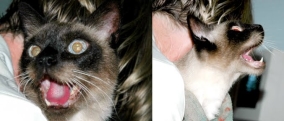
When severely stressed, some cats with hyperthyroidism will develop severe respiratory distress, rapid breathing, and panting; in addition, these cats may eventually become extreme weak or even collapse from exhaustion and shortness of breath. Hyperthyroid cats should therefore be handled carefully and in the veterinary office.
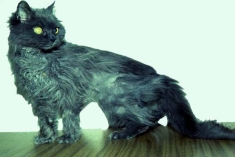 9. Skin, hair coat, and nail changes
9. Skin, hair coat, and nail changes
Skin and hair coat changes often develop in hyperthyroid cats. The hair coat, especially in long-haired breeds, is often unkempt, dull, and may even be matted.
Some hyperthyroid cats can groom obsessively resulting in alopecia (baldness) or a miliary dermatitis (crusty rash, often with intense itching). This is sometimes associated with an underlying skin allergy, but the skin problem is magnified by the cat’s apparent obsessive and compulsive behavior associated with increased licking and grooming.
Excessive nail growth may also occur, especially in cats with chronic and advanced hyperthyroidism. These nails appear thickened and may be more fragile that normal.
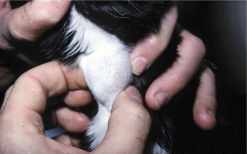
10. Apathetic hyperthyroidism
A small percentage (less than 5%) of hyperthyroid cats will show atypical signs where hyperexcitability or restlessness is replaced by depression, apathy, or weakness. Although weight loss is present in these cats, it is accompanied by poor appetite, instead of increased appetite. These disparate signs heighten the importance of clinicians having a high index of suspicion for such a common disease.
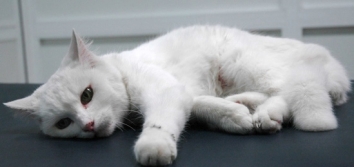
Many cats with apathetic hyperthyroidism will have concurrent severe non-thyroidal illness such as kidney failure, heart disease, or cancer. Therefore, it is wise to do a complete workup in these cats searching for secondary or concomitant disorders. Occasionally, however, no other medical problem can be identified and the cats respond completely to treatment of hyperthyroidism alone, with resolution of the depression and poor appetite.
In my next blog post, I’ll describe the 10 most common findings that your veterinarian may find when they perform a physical examination on a hyperthyroid cat.
Źródło: hanimalendocrine.blogspot.com
© 2024 © Vetco 2015. Wdrożenie: Pracownia Synergii









